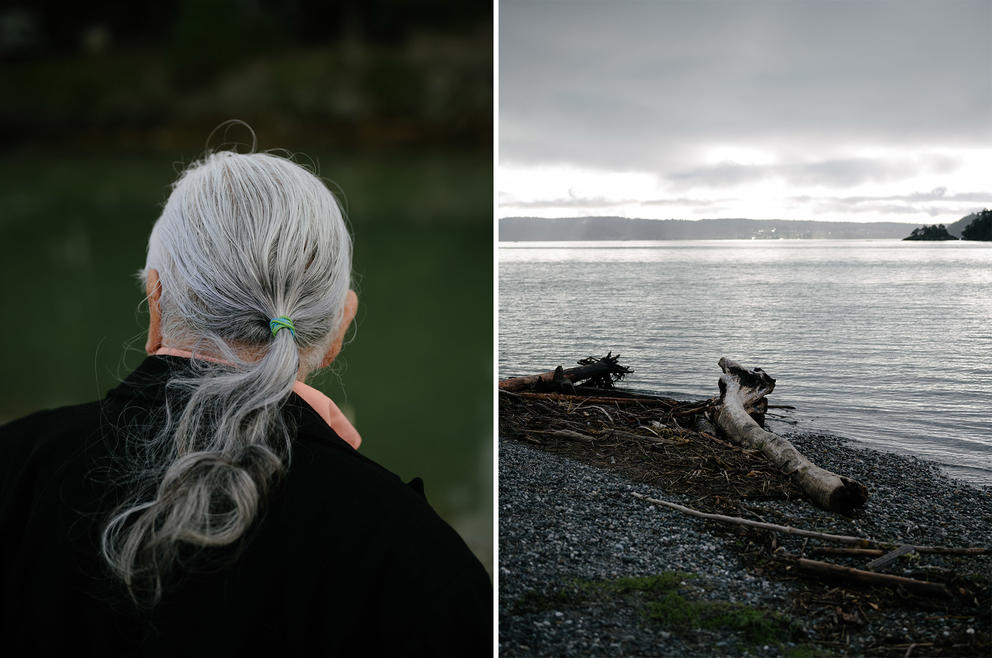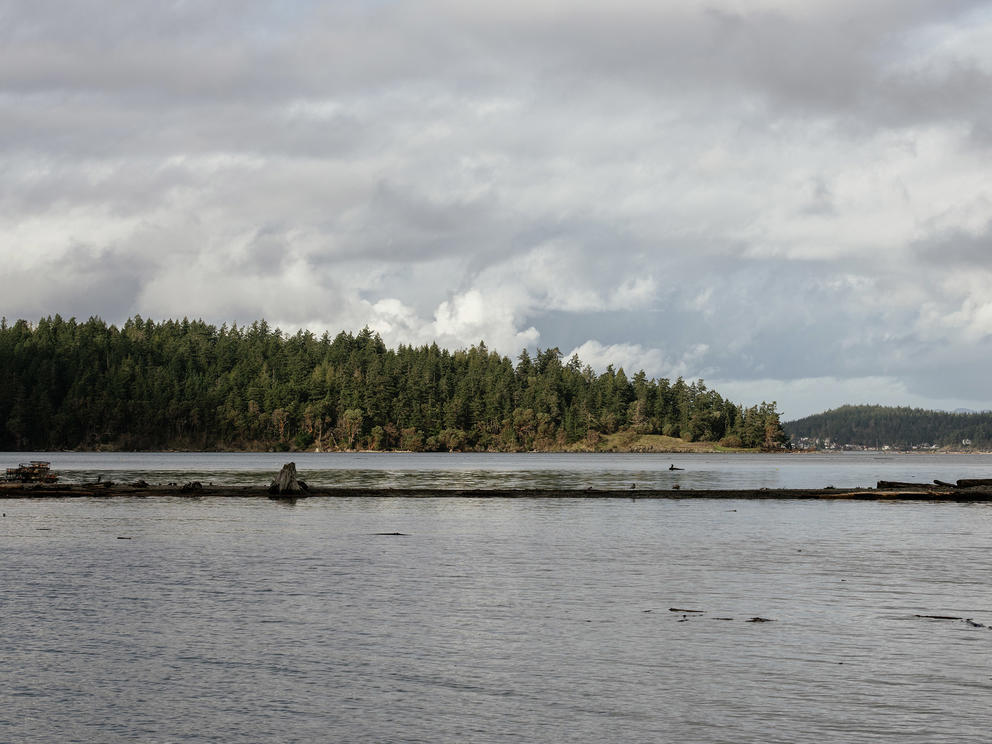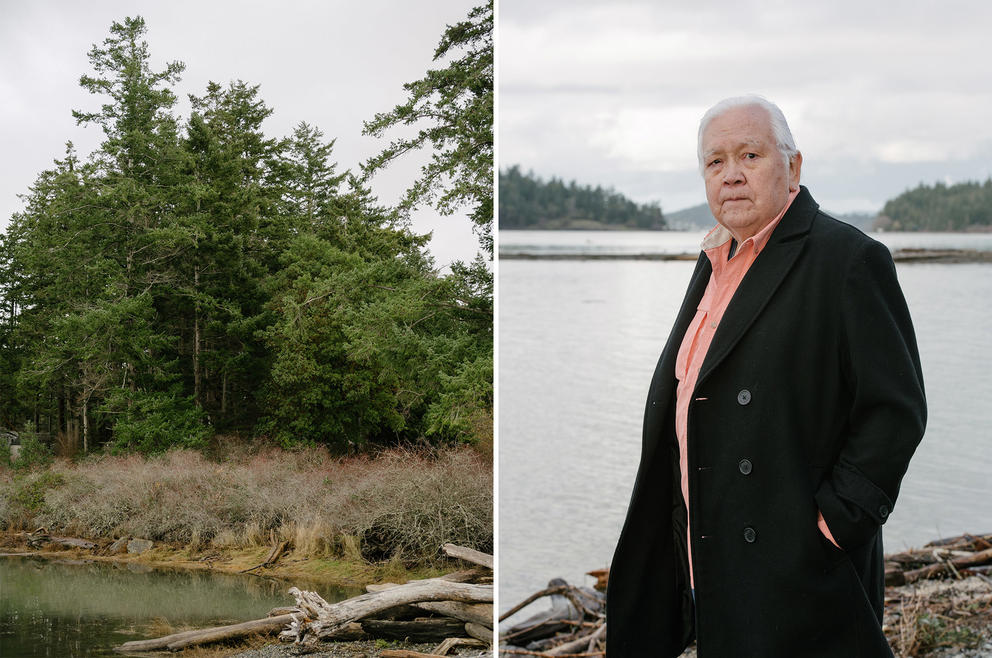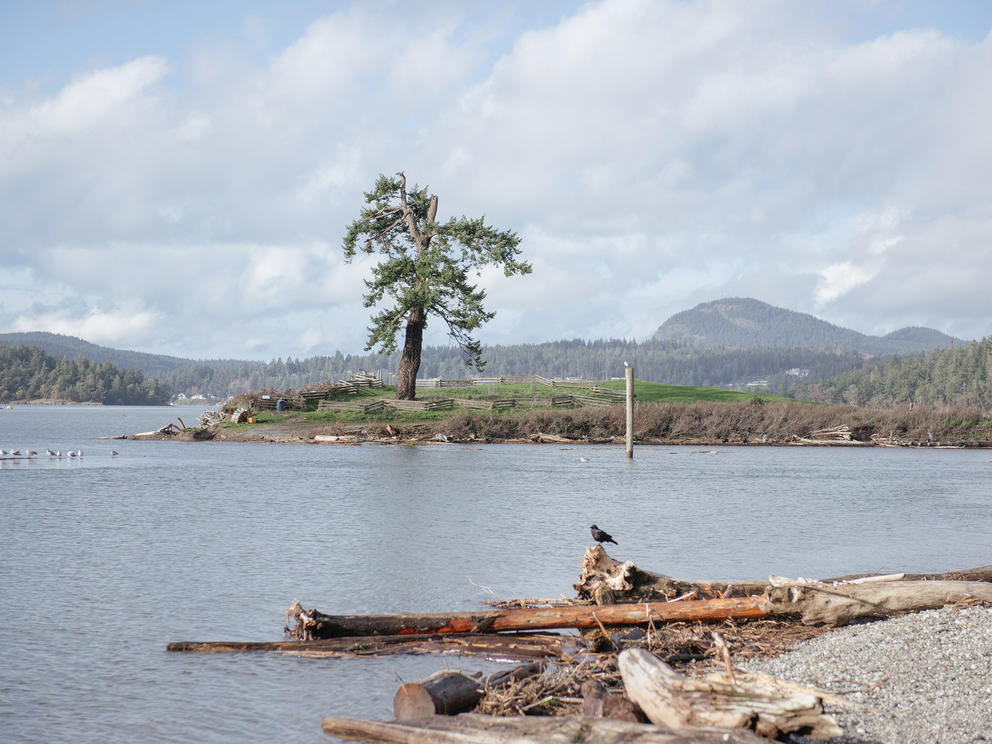“It’s about tending your land, your beach, and taking care of what’s around you. The beaches need us as much as we need them,” Williams said.
So the community grew concerned when Swinomish harvesters started reporting declines of littleneck and butter clams within traditional shellfish harvesting areas. The two clams are traditional foods that are important for both Swinomish culture and nutrition.
“Our body, as our spirit, needs clams,” said Larry Campbell, a tribal elder and community environmental health specialist. “When we crave these certain foods, it’s our spirits demanding to be fed in certain ways.”
The Swinomish tribal area sits at a low elevation, with about 95% abutting the water, so the community was already sensitive to changing ocean conditions before the noticeable clam decline took place over the past few decades. The decline drove home that things needed to change if tribal members were going to protect not only their food sources, but also their identity from climate impacts including ocean acidification, flooding and temperature increases.
Like Williams, members of each generation rely on previous ones to learn how to tend shorelines, and properly harvest shellfish revealed at low tide. “We’re losing some of our most important ancestral teachings,” said Williams, the tribe’s shellfish liaison.
Shellfish beds are important community gathering places for sharing stories and skills. Because Coast Salish people are also place-based, changes to the environment affect people’s cultural identity, Campbell said.
Plans to rejuvenate the historic cultural practice could turn the tide for shellfish harvesting for the tribe.
Tribal members are preparing to build a clam garden along a roughly 200-foot section of shoreline of tiny Kiket Island, just northwest of La Conner. The island is largely occupied by Kukutali Preserve, which is co-owned by the tribe and the Washington State Parks and Recreation Commission. Marine ecologist Courtney Greiner, who is employed with the tribe, describes clam gardens as low human-made rock terraces in the intertidal zone. The gardens create more level space for clams to mature.
The practice of clam gardening is thousands of years old, but Indigenous communities likely haven’t built a clam garden in the Pacific Northwest in modern times , said marine ecologist Dr. Marco Hatch, a member of the Samish Indian Nation and an associate professor of environmental sciences at Western Washington University.
If the Swinomish build theirs, tribal members and clam garden experts say, it would not only provide opportunities for cultural connection, food and knowledge sharing, but they believe it would be the first modern-day clam garden in the United States.
Evidence of historic clam gardens at different sea levels suggest that Coast Salish peoples adapted to changing seas in the past.
“Clam gardens came to be as a way of providing for people throughout change,” Williams says. “And now that we're witnessing the decline of these populations…. We're going to employ our ancestral technology to help us adapt.”
Alarm bells
The Swinomish Tribe’s harvesting prospects had been improving since 1975, when the historic Boldt decision reasserted tribal rights to their customary fishing grounds. But changing climate conditions and pollution hobbled some of those prospects. The tribe created a climate adaptation plan in 2010, in which they noted that shellfish are an important food source, second only to salmon. The climate plan listed protecting shellfish beds as a priority, and also made preserving tribal members' ability to exercise their treaty rights and cultural practices a goal.
Williams was a tribal senator when people first fielded the concept of a clam garden, around 2015. Up until now, he says, the huge abundance of clams and oysters near the Fidalgo Island-based Swinomish reservation meant there wasn’t really a need for one. But when he heard the idea, he jumped on board immediately.
“I think this is exactly what we need to bring some enthusiasm to our children about being a part of something that's going to last for generations, and help us pass along ancestral teachings,” he says. “And I think most of all, I'm excited about utilizing some of our ancestral knowledge to take care of us, to adapt to climate change.”
Clam gardening, in addition to being a historically recognized way of growing shellfish, is also effective. Clams grow on their own in the wild, but they grow bigger and faster in clam gardens than on beaches without gardens. According to research conducted by Simon Fraser University and the University of Washington, they can grow up to 300% more densely in gardens.
That’s extremely important for a food source that grows over the course of years, Western Washington University’s Hatch said. The gardens increase the number of clams the beach can support, and clams that grow faster can be harvested sooner, meaning people can harvest more clams without impacting the population.
To create clam gardens, Indigenous communities in the U.S. and Canada historically cleared beaches and moved rocks roughly the size of basketballs to low-tide lines to create walls, or terraces. Over time, the area behind the wall would fill in with sediment and shell hash — broken bits of shells — then flatten out and fill in to create a garden bed.
Just as with a vegetable garden, Hatch says, clam gardens require regular care and demonstrate that people can interact with and harvest from nature in a mutually beneficial way. Tribes maintain the rock terrace as it weathers storms and waves. They remove seaweed, and dig clams strategically, selecting larger clams and making space for smaller ones. If they don’t till the beach, it can get too compact and low in oxygen for baby clams to take root. “People often refer to that as fluffing the beach,” Hatch says.
It’s a time- and energy-intensive responsibility, but one that can connect generations to each other. “It's much, much more than just some rocks in the low tide line, right? It's a really culturally important practice that takes a lot of protocol to activate and maintain,” Hatch said.
But the work is worth it. In addition to being culturally important, clams also help filter water and shuttle nutrients through the ecosystem. Ecologists are excited to see whether clam gardens can not only survive climate change, but mediate some of its effects, like ocean acidification, as well as enhance biodiversity.
Hatch has been helping create exposure around clam gardening through the Clam Garden Network, a knowledge-sharing collaboration among Indigenous communities, academics, researchers and resource managers between Washington state and Alaska. The practice has fallen out of favor, but with increasing concern about climate change, more tribal communities are talking about ways to restore and reactivate Indigenous technologies, Hatch said.
Members of First Nations, tribes and partner organizations throughout the Pacific Northwest have worked to bring back clam gardens and other aquaculture for a few years through the Clam Garden Network and beyond. To date, First Nations in Canada have restored two clam gardens at Russell Island and Fulford Harbor, Hatch said, partnering with Parks Canada. The Swinomish consulted both First Nations working groups and Parks Canada to learn about that project, and from Native communities in Hawaii that have been working on fish pen projects through the Indigenous Aquaculture Collaborative Network supported by the National Oceanic and Atmospheric Agency’s Sea Grant.
Producing more clams is one goal, but in these projects, Hatch said, the community connection is vastly more important than the food itself. People are passionate about these projects because they are about reasserting rights, reaffirming people's cultural identity to place,and acknowledging Indigenous peoples' roles in shaping and modifying ecosystems over thousands of years, Hatch said.
Williams thinks the garden could fundamentally change Swinomish lifestyles. A lot of current clam harvesting in the area is done by commercial operations, but community members want to use the garden for education and subsistence harvest. “The ability for us to have this space to gather on the beach again, and share these stories and just be back to our way of life on the beach, I think, is going to impact our people in a larger way than they can anticipate today,” he said.
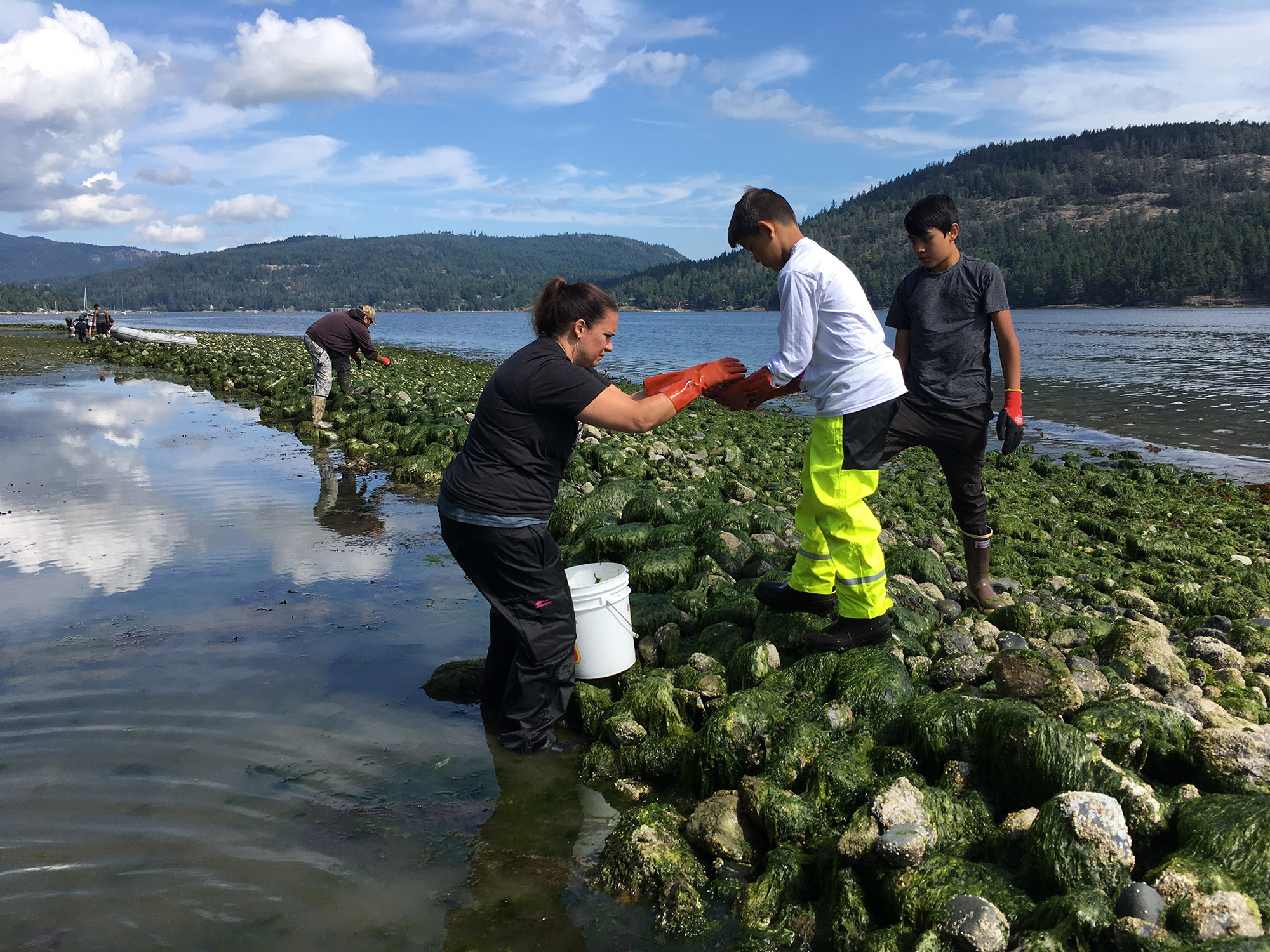
Getting things started
When the Swinomish decided to explore where to put a garden, Greiner said, a project team put together a technical advisory board. Based on insights from the board, the team looked for places that include benefits like easy access to where people live, high current flow, and juvenile clams already present; and then focused on locations where a garden would be minimally interruptive to the wildlife already living there. Clams thrive in areas with a high stream flow, a mix of fine sediment, pebbles and shells, gentle wave energy and enough food.
“Places are not neutral. Many places hold wonderful histories tied to individual family relationships and memories of harvesting and feasting on the beach; yet in some cases there are also difficult memories for which restored uses and caretaking could bring healing,” said Dr. Melissa Poe, who leads Washington Sea Grant’s social science program and supports the Swinomish clam garden project.
They ultimately surveyed 15 sites along the shore and landed on a 200-foot section that is on the smaller side, but manageable for a first attempt, Greiner said.
Williams expects it to take five to 10 years after building the garden before the terrace wall foundation really bears an abundance of clams.
Hurdles to overcome
Finding funding to build the garden was a big hurdle, but this year, the tribe received money from the NOAA Saltonstall-Kennedy Competitive Grants Program and the Northwest Climate Adaptation Science Center. The funds will go not only to building the garden and hosting community events, but also to collecting data before and after the site is built to see how the garden changes the area, with a particular emphasis on climate change mitigation.
But fitting ancient practices with the modern permitting process is the biggest thing standing in the tribe's way. The Swinomish Tribe is waiting on a Section 10 Permit from the Army Corps of Engineers. Greiner said while clam gardening is an established practice, it’s something USACE hasn’t seen before.
“The practice is such a holistic ecosystem-based approach to enhancing native species that it seems like an obvious win-win for the environment and local communities, so I think we’ll eventually get the approval. It’s just a matter of bringing everyone along with us,” she said.
It’s frustrating waiting for permission “to basically do what we do,” Williams said. “That is the one thing right now that is holding us up. We’re pretty much ready to start moving rocks.”
In his opinion, this should be part of Swinomish treaty rights, as it’s a part of tending to the tribe’s own reservation, as well as the Salish Sea.
He’s eager to share the practice with his two sons and two daughters.
“I think sometimes our younger generation has lost sight of the ancestral way of life, as being a part of land and being at one with nature. And sometimes they only see the economic benefit to what we do,” he said. “I have explained to my kids that they have to learn all of these practices, these ancestral teachings, so that they can pass them on to their children, my grandchildren.”

